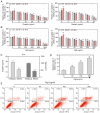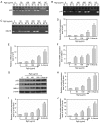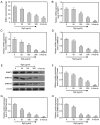Effects of ginsenoside Rg3 on epigenetic modification in ovarian cancer cells
- PMID: 31002353
- PMCID: PMC6489025
- DOI: 10.3892/or.2019.7115
Effects of ginsenoside Rg3 on epigenetic modification in ovarian cancer cells
Abstract
Epigenetic modifications are closely related to oncogene activation and tumor suppressor gene inactivation. The aim of this study was to determine the effects of ginsenoside Rg3 on epigenetic modification in ovarian cancer cells. Cell proliferation, metastasis, invasion and apoptosis were respectively determined using Cell Counting Kit‑8 (CCK‑8), wound healing, Transwell and flow cytometric assays. Methylation levels were determined using methylation specific PCR (MSP). Related‑factor expression was detected by conducting real‑time‑qPCR (RT‑qPCR) and western blotting. The results revealed that cell proliferation was inhibited by ginsenoside Rg3 (0, 25, 50, 100 and 200 µg/ml) in a time‑dependent manner (12, 24 and 48 h). Ginsenoside Rg3 (50, 100 and 200 µg/ml) was selected to treat cells in various experiments. When ovarian cells were treated with ginsenoside Rg3, cell apoptosis was observed to be promoted, while cell metastasis and invasion were inhibited at 48 h. The results of the present study revealed that in the promoter regions of p53, p16 and hMLH1, the methylation levels decreased, while the mRNA and protein levels significantly increased. The activities of DNMTs and mRNA as well as protein levels of DNMT1, DNMT3a and DNMT3b were decreased by Rg3. The data also demonstrated that the mRNA and protein levels of acetyl‑H3 K14/K9 and acetyl‑H4 K12/K5/K16 were increased by Rg3. Hence, ginsenoside Rg3 inhibited ovarian cancer cell viability, migration and invasion as well as promoted cell apoptosis.
Figures





Similar articles
-
Ginsenoside 20(S)-Rg3 Inhibits the Warburg Effect Via Modulating DNMT3A/ MiR-532-3p/HK2 Pathway in Ovarian Cancer Cells.Cell Physiol Biochem. 2018;45(6):2548-2559. doi: 10.1159/000488273. Epub 2018 Mar 16. Cell Physiol Biochem. 2018. PMID: 29558748
-
[Ginsenoside 20(S)-Rg3 upregulates tumor suppressor VHL gene expression by suppressing DNMT3A-mediated promoter methylation in ovarian cancer cells].Nan Fang Yi Ke Da Xue Xue Bao. 2021 Jan 30;41(1):100-106. doi: 10.12122/j.issn.1673-4254.2021.01.14. Nan Fang Yi Ke Da Xue Xue Bao. 2021. PMID: 33509760 Free PMC article. Chinese.
-
Ginsenoside Rg3 inhibits cell growth, migration and invasion in Caco-2 cells by downregulation of lncRNA CCAT1.Exp Mol Pathol. 2019 Feb;106:131-138. doi: 10.1016/j.yexmp.2019.01.003. Epub 2019 Jan 8. Exp Mol Pathol. 2019. Retraction in: Exp Mol Pathol. 2022 Aug;127:104785. doi: 10.1016/j.yexmp.2022.104785. PMID: 30633886 Retracted.
-
Gene methylation in gastric cancer.Clin Chim Acta. 2013 Sep 23;424:53-65. doi: 10.1016/j.cca.2013.05.002. Epub 2013 May 10. Clin Chim Acta. 2013. PMID: 23669186 Review.
-
Anticancer effects of ginsenoside Rg3 (Review).Int J Mol Med. 2017 Mar;39(3):507-518. doi: 10.3892/ijmm.2017.2857. Epub 2017 Jan 13. Int J Mol Med. 2017. PMID: 28098857 Review.
Cited by
-
New Wenshen Shengjing Decoction Improves Early Embryonic Development by Maintaining Low Levels of H3K4me3 in Sperm.Biomed Res Int. 2022 Feb 21;2022:9775473. doi: 10.1155/2022/9775473. eCollection 2022. Biomed Res Int. 2022. PMID: 35237692 Free PMC article.
-
Carbon nanotubes (CNT)-loaded ginsenosides Rb3 suppresses the PD-1/PD-L1 pathway in triple-negative breast cancer.Aging (Albany NY). 2021 Jun 10;13(13):17177-17189. doi: 10.18632/aging.203131. Epub 2021 Jun 10. Aging (Albany NY). 2021. PMID: 34111025 Free PMC article.
-
Unveiling the experimental proof of the anticancer potential of ginsenoside Rg3 (Review).Oncol Lett. 2024 Feb 28;27(4):182. doi: 10.3892/ol.2024.14315. eCollection 2024 Apr. Oncol Lett. 2024. PMID: 38476209 Free PMC article. Review.
-
Targeting the DNA damage response (DDR) of cancer cells with natural compounds derived from Panax ginseng and other plants.J Ginseng Res. 2025 Jan;49(1):1-11. doi: 10.1016/j.jgr.2024.04.001. Epub 2024 Apr 9. J Ginseng Res. 2025. PMID: 39872282 Free PMC article. Review.
-
Identification of LncRNA Prognostic Markers for Ovarian Cancer by Integration of Co-expression and CeRNA Network.Front Genet. 2021 Feb 16;11:566497. doi: 10.3389/fgene.2020.566497. eCollection 2020. Front Genet. 2021. PMID: 33664764 Free PMC article.
References
-
- Henderson JT, Webber EM, Sawaya GF. U.S. preventive services task force evidence syntheses formerly systematic evidence reviews Screening for ovarian cancer: An updated evidence review for the U.S. preventive services task force. Agency for Healthcare Research and Quality (US) 2018 Report No.: 17-05231-EF-1. - PubMed
-
- Smith RA, Manassaram-Baptiste D, Brooks D, Doroshenk M, Fedewa S, Saslow D, Brawley OW, Wender R. Cancer screening in the United States, 2015: A review of current American cancer society guidelines and current issues in cancer screening. CA Cancer J Clin. 2015;65:30–54. doi: 10.3322/caac.21261. - DOI - PubMed
MeSH terms
Substances
LinkOut - more resources
Full Text Sources
Medical
Research Materials
Miscellaneous

